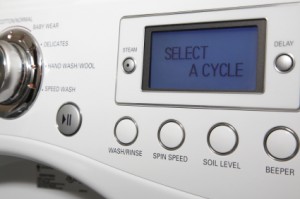If your washing machine stinks, don’t worry, you’re not alone. Washer mildew and odors are one of the most common complaints amongst homeowners. However, it is possible to alleviate the smell through a few simple steps.
Identify Why Your Washing Machine Stinks
Most of the time, a musty or mildew smell in or around your washer (or on your clothes!) is indicative of mold growing in your washing machine. Mold is a living organism that, in addition to a food source, needs warm, damp conditions to thrive.
There are several things that may cause mildew to grow in your washer including residual water, misuse of detergent and fabric softener, and bad laundry habits in general. Lint, dirt, soap and even skin and hair can also accumulate in the drain pump filter or under the agitator. And this constantly wet, decaying matter (aka “gunk”) can really start to stink over time.
Clean Under The Agitator Or Drain Pump Filter
If your washing machine stinks, this is one of the less obvious culprits. It requires a tad bit more work than throwing some bleach or washing machine cleaner into the clean cycle, but it can effectively eliminate the “gunk” at the root cause of the stench.
Typically, your washing machine’s instruction manual will tell you how, and how often, to clean under the agitator or the drain pump filter. Top and front loaders are different in the way they operate and drain, so there are different methods for both.
For a top loader, you’ll need to remove the agitator to get to the “gunk.” Usually, there is a top that can be popped off to expose a bolt in the agitator. Removing the bolt allows the agitator to be lifted up out of the washer. Once removed, clean in, under and around the agitator with a hot water and bleach solution.
A front loader washer does not always drain completely so they typically have a panel on the bottom, either exposed or hidden, that contains the drain pump filter. Removing the panel will expose a drain. Make sure you have a bucket and a towel handy as some water will come out when the drain is released. Once the water is drained, the filter can be removed and the “gunk” cleaned out. Most manufacturers recommend cleaning the filter once a month.
Use a Washing Machine Cleaner
A washing machine cleaner, such as Smelly Washer, uses natural ingredients to remove odor, fungus and mildew from your washer. If your washing machine stinks, simply follow the instructions and add some washing machine cleaner to its cleaning, or hottest, cycle. For tougher odors, repeat the process. Use a washing machine cleaner up to twice a month to prevent mildew from returning.
Washer mildew is not the end of the world. With a little elbow grease and a quality washing machine cleaner, your smelly washer will be a distant memory.
